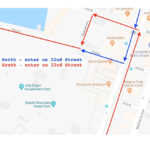Building a Bike Without Pedals might seem like a straightforward customization, but it quickly runs into complex legal and practical hurdles in many regions. The core issue stems from vehicle classification: in numerous places, a bike lacking pedals may not qualify as a bicycle under legal definitions, potentially making it illegal to operate on roads or sidewalks.
Missouri stands out as an exception, seemingly indifferent to the presence of pedals on what might otherwise be considered a bicycle. However, for most other locations, especially if you aim to register a pedal-less bike as a non-bicycle class vehicle, the challenge escalates significantly. This is where the Vehicle Identification Number (VIN) becomes crucial.
Securing a VIN for a custom-built vehicle is notoriously difficult, often bordering on impossible in some jurisdictions for practical purposes. To navigate this, builders often resort to using a frame from a vehicle that already possesses a VIN and a clean, non-salvage title. This involves incorporating the frame section bearing the VIN, alongside any components necessary to comply with local customized-vehicle regulations. The legal consequence of this approach is that your creation essentially inherits the vehicle class of the donor frame, along with all the associated legal obligations.
In essence, if you’re set on a bike without pedals, converting an existing motorcycle into an electric motorcycle presents a more streamlined path, allowing for extensive customization within legal boundaries. This approach bypasses the VIN and registration quagmire associated with creating a pedal-less vehicle from scratch.
For those willing to incorporate pedals and explore the electric bicycle route, adherence to local regulations is paramount. Taking Texas as an example, their statutes define specific requirements for electric bicycles. These include being “designed to be propelled by an electric motor, exclusively or in combination with the application of human power” and stipulating speed and weight limits. Specifically, in Texas, an electric bicycle cannot exceed 20 miles per hour without human power and must not weigh more than 100 pounds. While a quick search doesn’t reveal specific registration requirements for bicycles, electric or otherwise, understanding these definitions is crucial for legal compliance.
It’s also worth noting that in many areas, a motorcycle-class driver’s license typically encompasses the authorization to operate smaller vehicle types, including mopeds and scooters. This licensing hierarchy can simplify the legal landscape for some pedal-less vehicle configurations.
The question “why no pedals?” and the curiosity about “why two motors” are valid points to consider. While the original query’s motivation remains unspecified, understanding the legal and practical implications is crucial before embarking on a build that deviates from standard bicycle or electric bicycle norms.
There’s apparently no law in TX (that appears to be where you’re at) that you can’t ride a bicycle at 30mph.
Click to expand…
However, even in a state like Texas with seemingly lenient speed laws for bicycles, the definition of an “electric bicycle” hinges on the integration of human power and limits the speed attainable without pedaling to 20 mph. This distinction underscores the legal tightrope walk when venturing into pedal-less bike designs.
(24) “Electric bicycle” means a bicycle that: (A) is designed to be propelled by an electric motor, exclusively or in combination with the application of human power;
(B) cannot attain a speed of more than 20 miles per hour without the application of human power; and
(C) does not exceed a weight of 100 pounds.
Click to expand…
Ultimately, while the concept of a bike without pedals might be appealing for various reasons, navigating the legal definitions, registration processes, and vehicle classifications requires careful consideration and adherence to local laws. Exploring electric motorcycle conversion or embracing e-bike regulations with pedals often presents a more legally sound and practically viable path.

